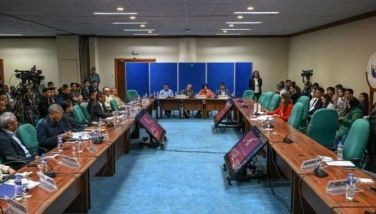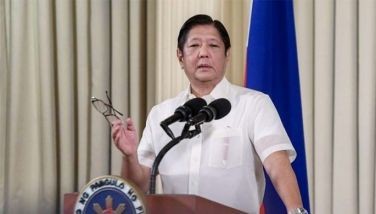‘Crony capitalism’ under Marcos tyranny revisited

Worth noting and scrutinizing is how Ferdinand “Bongbong” Marcos Jr. has risen to the top ranking in surveys among the vice presidential candidates in the May 9 elections: He’s statistically tied with Leni Robredo in the latest SWS survey, and enjoys high preference among the ABC class.
This, despite Bongbong’s adamant refusal to admit and apologize for the crimes and abuses inflicted upon the people by his father in over 20 years in power – 14 years as a dictator, until his ouster through popular uprising in 1986.
Do Bongbong’s rich backers in the ABC group remember how Marcos plundered state resources to line his pocket and those of his friends? The surviving cronies or their relatives and associates are eagerly awaiting vengeance if and when the dictator’s son manages to snatch the position.
To remind readers of this column, and apprise those who may not have been aware of it, let’s revisit one aspect of the Marcos dictatorship’s numerous accountabilities that Bongbong says should be left to the judgment of history. I refer to crony capitalism –the business operations of Marcos’ close friends and collaborators, sustained by generous government loans and guarantees, and bailed out with state funds when they mismanaged themselves into financial trouble.
The late Jaime V. Ongpin, then president of Benguet Corporation, coined the term “crony capitalism.” He exposed and consistently opposed it in the campaign to end the Marcos dictatorship.
In a paper written in March 1983 and presented to the Financial Executives Institute of the Philippines (and to two other organizations later), Ongpin made an incisive case and call for action against the Marcos regime. The paper is titled The Eleven MIPs (a.k.a. The Eleven Major Infuriating Problems), a jibe at Marcos’ Eleven Major Industrial Projects that never got implemented.
Ongpin focused on the case of the Construction and Development Corporation of the Philippines, one of the crony firms that had run to the ground and were being rescued with state funds. [After the bailout, CDCP became known as the Philippine National Construction Corporation.]The problem was presented thus:
• Prime Minister Cesar A. Virata blamed the previous policy of granting “liberal credit” (government loans and guarantees) to projects which later proved to be “not economically viable.” Ongpin rejected this. He bluntly asserted that the root of the problem was the borrowers’ “avarice and incompetence” and the lending institutions’ “lack of financial discipline and insufficient intestinal fortitude.”
• The bailout involved not only CDCP, he warned. It was “much larger and would remain a constant, heavy and perhaps debilitating burden on the back of the Philippine economy.”
• The size of the CDCP bailout was unprecedented in financial magnitude and frightening in its potential consequences. Aggregate debt was P7 billion, equivalent to the following: 27 percent of the entire money supply (P25.7 billion); 13 percent of total government spending in 1982 (P52.6 billion); 35 percent of all BIR-collected taxes in 1981 (P20 billion);and 29 percent of foreign exchange reserves ($2.5 billion).
• How did CDCP get to borrow P2 billion from the Philippine National Bank, which exceeded 70 percent of the state bank’s net worth, whereas the PNB charter allowed a borrower only 15 percent of its net worth? How many firms had been allowed to do this?
• How could the government justify the virtual wholesale condonation by “conversion to equity” of all CDCP debt to the PNB, when the debts exceeded 60 percent of the bank’s net worth and the unibanking law allowed only 15 percent for any single investment/equity?
• Why were all of CDCP debts converted into equity – virtually condoned – whereas in prior bailouts only a small portion of the debt was converted to equity, the rest restructured for longer-term repayment?
• Why were the principal stockholders of CDCP not required to comply with their personal guarantees and surrender to the PNB personal assets they had put up as collaterals? And why weren’t the officials of the PNB, who may have knowingly violated the law or prudent financial principles, called to “face the music?” Was this the new set of values to be bequeathed by Marcos’ “New Society”?
•Why was the CDCP bailout presented as a fait accompli to the public, and not subjected to legislative process in the Batasang Pambansa since it involved the public interest?
• Why was the CDCP bailout implemented by means of a Presidential Letter of Instruction? Did the President (Marcos) have the authority to do this in favor of a single private sector corporation? if he had, did he have similar authority to do the same for any other? How many others?
• Who – “if not the poor defenseless taxpayer” – ultimately would bear the cost of the CDCP bailout and all others like it?
“If the government succeeds in ramming down the CDCP bailout down our collective throats,” Ongpin asked, “is there not a clear and imminent danger that ‘converting loans into equity’… will become institutionalized as the ultimate panacea for the dozens upon dozens of sick and distressed companies with billions upon billions of past-due loans to government financial institutions?”
Aside from the debt burden, crony capitalism was one cause of the Philippine economy’s failure to grow. Should we risk having it revived?
(Postscript: Appointed by President Corazon Aquino as her first finance minister, Ongpin got into bitter conflict within the Cabinet over the $25-billion foreign debt left by Marcos. President Cory opted to fully repay even the bad loans, via Marcos’ PD 1177. Today the Philippine foreign debt is $59 billion.)
* * *
Email: satur.ocampo@gmail.com
- Latest
- Trending



























